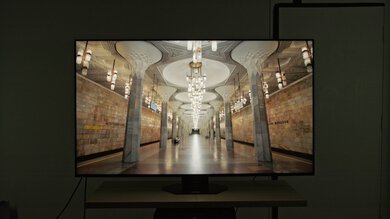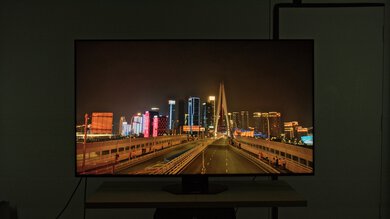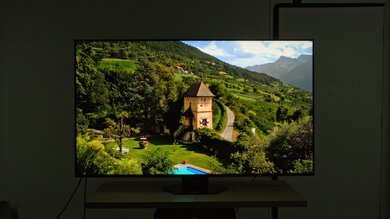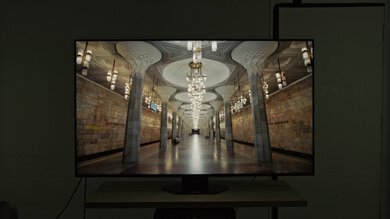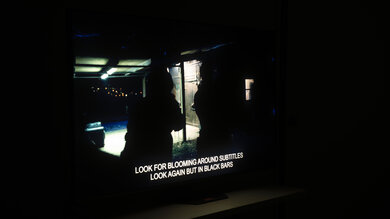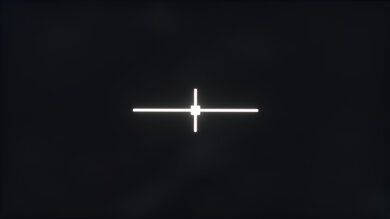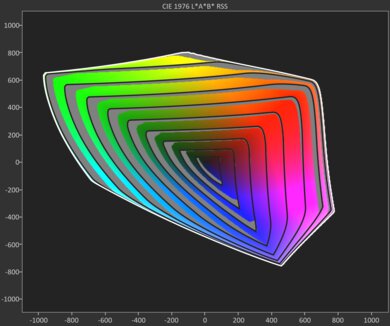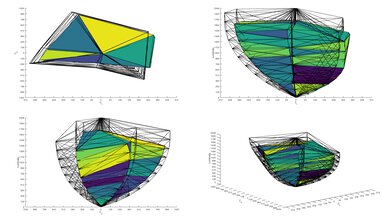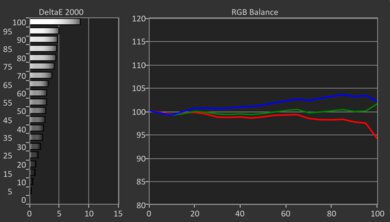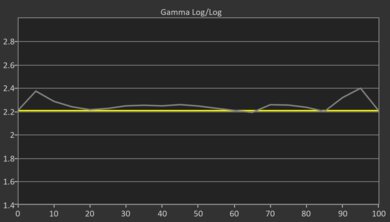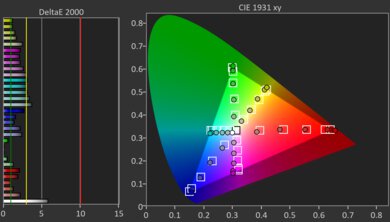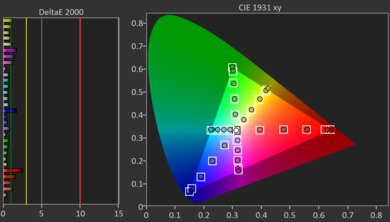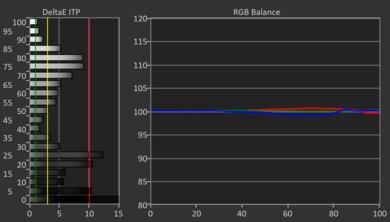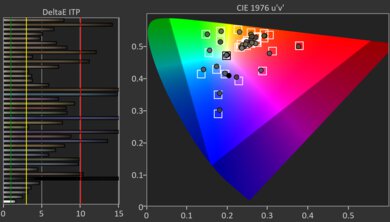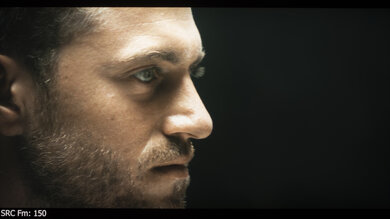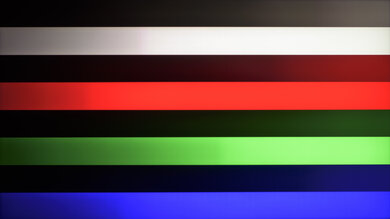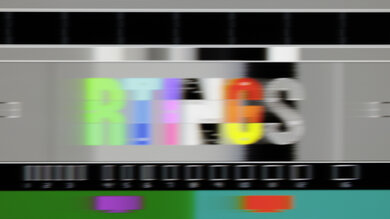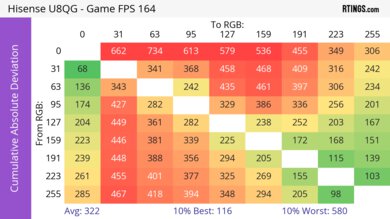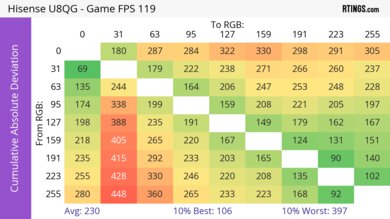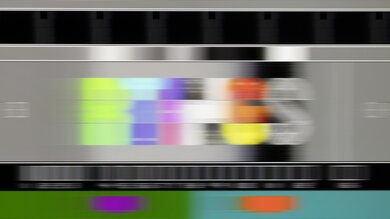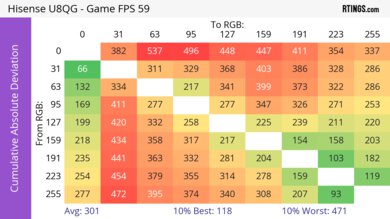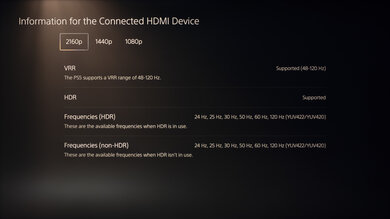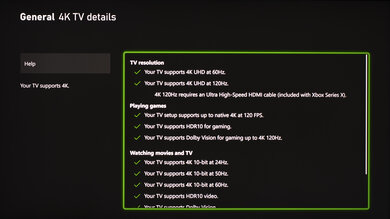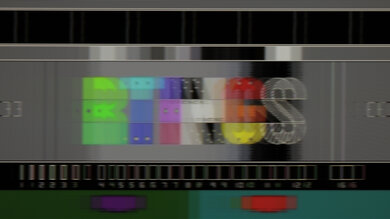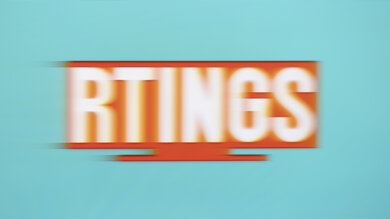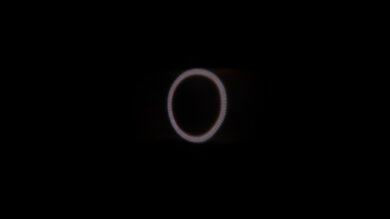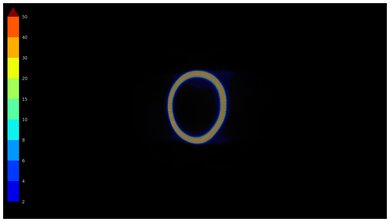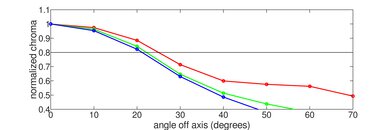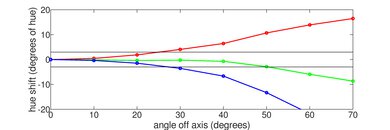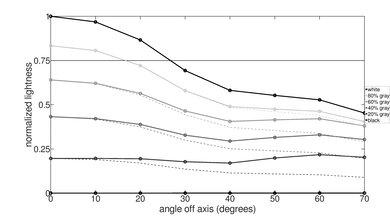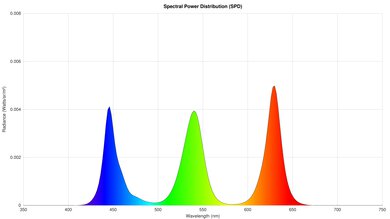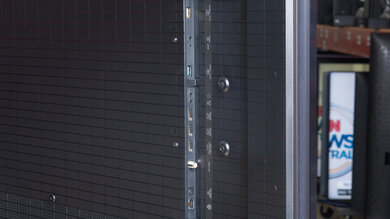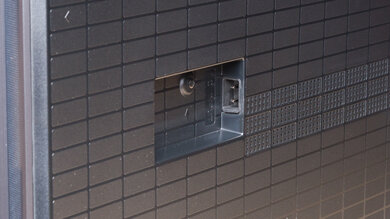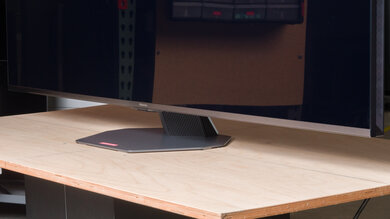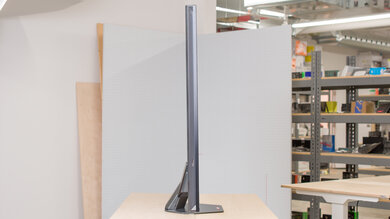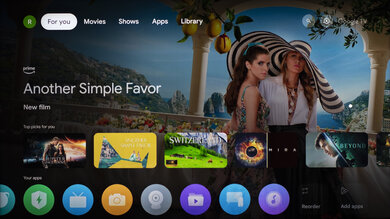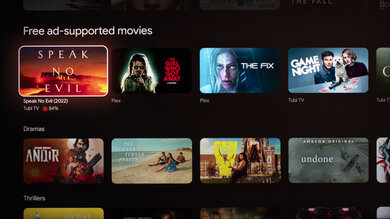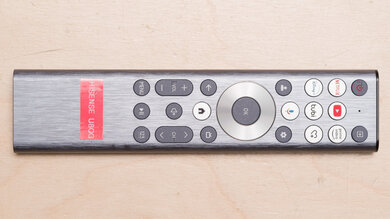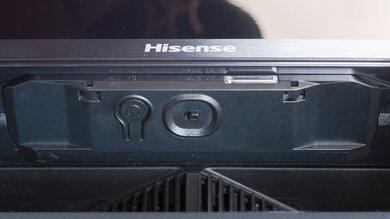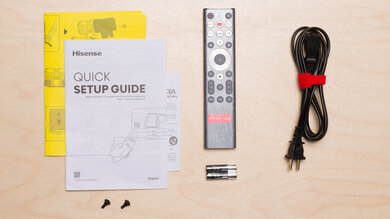The Hisense U8QG is a mid-range model released in 2025 and replaces the Hisense U8/U8N. It sits above the Hisense U6QF and the Hisense U7QG in Hisense's ULED lineup, and below the Hisense U9QG. It uses the Hi-View AI Engine Pro processor, has HDMI 2.1 bandwidth on all three ports, and is the first TV that has a USB-C port that can act as an alternate display port for PC gamers. Additionally, it has a ton of gaming features like 4k @ 165Hz, 1080p @ 288Hz, and VRR. It also supports Dolby Vision, HDR10+, and DTS audio formats. The TV utilizes the popular Google TV interface that's loaded with a ton of apps, and has smart features like voice control. We bought and tested the 65-inch model, but it's also available in 55, 75, 85, and 100-inch options.
Our Verdict
The Hisense U8QG is great for mixed usage. It looks great in reference conditions thanks to its excellent black levels, exceptional HDR brightness, and vibrant colors. This is a versatile TV, so you barely lose any image quality in a well-lit room, and it easily overcomes glare from indirect light sources. It also comes with a host of gaming features, making it fully compatible with consoles and a great addition to your gaming PC setup. Unfortunately, the TV's viewing angle is only okay, so if you have a big living room and regularly watch TV with a group of friends or family, there are better options.
-
Outstanding SDR brightness in all scenes.
-
Colors are vibrant, lifelike, bright, and accurate.
-
Very deep blacks with minimal blooming around highlights and subtitles.
-
Direct reflections are a bit distracting.
-
Image degrades when viewed from more aggressive angles.
-
The TV has a lot of bugs and strange quirks.
The Hisense U8QG is a great choice for a home theater. The TV displays very deep blacks that are about as close to an OLED as you can currently get, but there's some minor blooming around highlights and subtitles. Its HDR brightness is remarkable, so highlights in dimmer scenes and entirely bright scenes really pop out. Colors are vibrant and have good accuracy, but the TV does an awful job of displaying HDR content at the brightness level intended by the filmmaker, making everything look drastically too bright. There's some minor stutter during slow panning shots due to the TV's quick response time, but it's not as noticeable as it is on OLEDs, and not everyone will be bothered by it.
-
Exceptional HDR brightness in all scenes.
-
Colors are vibrant, lifelike, bright, and accurate.
-
Very deep blacks with minimal blooming around highlights and subtitles.
-
Great low-quality content smoothing and very good upscaling capabilities.
-
Awful PQ EOTF tracking means the TV over brightens HDR content.
The Hisense U8QG is excellent for use in a bright room. Its SDR brightness is outstanding, so the TV easily overcomes glare from indirect lighting in even the brightest of rooms. The TV also retains its color saturation and deep blacks in a well-lit room, so you don't have to worry about sacrificing picture quality when you flip your lights on. The only minor downside is that the TV only does an alright job handling direct reflections, so any light source you have placed opposite the screen is visible, especially during darker scenes.
-
Outstanding SDR brightness in all scenes.
-
Blacks remain deep and colors stay vibrant in a room with ambient lighting.
-
Direct reflections are a bit distracting.
The Hisense U8QG is impressive for watching sports. The TV is more than bright enough to overcome glare from indirect lighting, but its only alright handling of direct reflections means it's still best to avoid placing the TV screen opposite a lamp or window. The TV displays well-saturated colors with good accuracy, which is great if you want vibrant colors that look like what you would see if you were watching the game live. Its solid image processing means low-quality and low-resolution feeds still look pretty good, which is great if you mostly watch sports on cable. Finally, the TV's viewing angle is wide enough for a consistent image from a slight angle, but it's still not a great choice for wide seating arrangements.
-
Outstanding SDR brightness in all scenes.
-
Colors are vibrant, lifelike, bright, and accurate.
-
Great low-quality content smoothing and very good upscaling capabilities.
-
Direct reflections are a bit distracting.
-
Noticeable dirty screen effect and the corners of the screen are dimmer.
-
Image degrades when viewed from more aggressive angles.
The Hisense U8QG is great for gaming. It's loaded with a ton of modern gaming features like HDMI 2.1 bandwidth, a USB-C alt-display port, 4k @ 165Hz, 1080p @ 288Hz, and VRR, so it's a great option for gamers. However, 1080p @ 288Hz and VRR both don't work when using the USB-C port, which is a major drawback for PC gamers. Its low input lag means you get a responsive gaming experience, especially at higher refresh rates. Unfortunately, the TV has slow pixel transitions, so fast motion in games lack some clarity. Thankfully, this TV provides great picture quality with vibrant colors, deep blacks, and remarkable brightness, so your favorite games look excellent.
-
Exceptional HDR brightness in all scenes.
-
Colors are vibrant, lifelike, bright, and accurate.
-
Low input lag at higher refresh rates for a responsive feel.
-
Slow pixel transitions mean fast motion lacks some clarity when gaming.
-
1080p @ 288Hz and VRR don't work while using the USB-C input as a display port.
The Hisense U8QG has remarkable brightness overall. Its SDR brightness is outstanding across the board, so this TV easily overcomes glare from indirect lighting in a well-lit room. The TV's HDR brightness is exceptional; small highlights really pop out during dim and moderately lit scenes, and well-lit scenes are incredibly bright.
-
Exceptional HDR brightness in all scenes.
-
Outstanding SDR brightness in all scenes.
The Hisense U8QG has excellent black levels. The TV's contrast is superb, especially for an LED model, so blacks are very deep. The TV's lighting zone precision is great, but there's still subtle blooming around small highlights and subtitles. Unfortunately, the TV's black uniformity is only decent, so you notice some small patches of uneven brightness during purely dark scenes.
-
Very deep blacks with minimal blooming around highlights and subtitles.
The Hisense U8QG has great colors overall. Colors are vivid and lifelike in both SDR and HDR, so you get a vibrant viewing experience regardless of the content. The TV has good enough color accuracy overall that most people will be pleased with how close it stays true to the filmmaker's intent, but color enthusiasts will likely feel the need to get it professionally calibrated.
-
Colors are vibrant, lifelike, bright, and accurate.
Note: We're in the process of improving our tests related to image processing, but this score should give you a general idea of how a TV performs overall with its image processing capabilities.
The Hisense U8QG has okay processing overall. It does a great job removing artifacts from low-quality content, and low-resolution content is upscaled well enough that the image doesn't look soft. The TV does a very good job of displaying color gradients, with only noticeable banding in bright greens. Unfortunately, the TV's PQ EOTF tracking is awful; all scenes in HDR content are drastically brighter than intended.
-
Great low-quality content smoothing and very good upscaling capabilities.
-
Very good handling of color gradients.
-
Awful PQ EOTF tracking means the TV over brightens HDR content.
The Hisense U8QG has good responsiveness while using its dedicated gaming mode. The TV supports VRR (only supported through HDMI), has HDMI 2.1 bandwidth on all three ports, and has a USB-C port to use as an alternate display port for PC gamers. It supports 4k @ 165Hz and 1080p @ 288Hz, but the latter is only possible when using an HDMI input, which is a drawback for PC gamers who want the highest possible refresh rate while using the USB-C alt-display port. The TV has low input lag, especially at 165Hz and 288Hz, but it is a bit higher than the Hisense U8/U8N at 60Hz and 120Hz. Unfortunately, the TV has slow pixel transitions, so fast motion has some noticeable blur behind it.
-
Low input lag at higher refresh rates for a responsive feel.
-
Slow pixel transitions mean fast motion lacks some clarity when gaming.
-
1080p @ 288Hz and VRR don't work while using the USB-C input as a display port.
We're in the process of fixing the way we evaluate a TV's overall motion handling. This section is currently broken, and the score isn't indicative of how well a TV handles motion overall.
- 8.2 Mixed Usage
- 8.3 Home Theater
- 8.7 Bright Room
- 8.2 Sports
- 8.2 Gaming
Performance Usages
- 9.2 Brightness
- 8.6 Black Level
- 8.4 Color
- 6.7 Processing (In Development)
- 7.4 Game Mode Responsiveness
- 7.8 Motion Handling (Broken)
Changelog
-
Updated Jun 06, 2025:
We adjusted the score from a 7.5 to an 8 in the Upscaling: Sharpness Processing section to better align with our other 2025 Hisense TV reviews.
-
Updated May 26, 2025:
We updated the Black Frame Insertion section to make it clear that 60Hz isn't supported.
- Updated May 23, 2025: Review published.
- Updated May 16, 2025: Early access published.
- Updated May 06, 2025: Our testers have started testing this product.
Differences Between Sizes And Variants
We bought and tested the 65-inch Hisense U8QG, but most of our results should also be valid for the 85-inch model. The 55, 75, and 100-inch models are reported to use an ADS Pro panel instead of a VA panel, so most of our results aren't valid for those three sizes. All sizes of the TV are advertised as having a peak brightness of up to 5000 nits, but it's highly likely that the peak brightness is different depending on the size.
In Canada, the TV is known as the Hisense U88QG, and it performs the same. There are similarly named international models, like the U8QAU in Australia, but Hisense models typically perform a bit differently in regions outside of North America, so our results aren't valid for them.
| Size | US Model | Advertised Dimming Zones | Panel Type (Unconfirmed) |
| 55" | 55U8QG | 1008 | ADS Pro |
| 65" | 65U8QG | 2048 (Confirmed) | VA |
| 75" | 75U8QG | 2160 | ADS Pro |
| 85" | 85U8QG | 3168 | VA |
| 100" | 100U8QG | 5376 | ADS Pro |
Our unit was manufactured in February 2025, and you can see our unit's label here.
Compared To Other TVs
The Hisense U8QG is a worthy successor to the 2024 Hisense U8/U8N. It's even brighter and has a solid uptick in contrast compared to the 2024 model. It's also loaded with modern features and attempts to cater to PC gamers with its USB-C alt-display port and high refresh rates. However, the TV's gaming performance is a bit held back by the fact that VRR and 1080p @ 288Hz both don't work when using the USB-C port. Additionally, the TV's pixel transitions are pretty slow overall, so fast motion in games lack some clarity. On the other hand, the TV performs very well in a bright room, but home theater enthusiasts will likely be disappointed by its awful PQ EOTF tracking that significantly over-brightens the image. If you want a Mini LED model for a dark room, you can get much better accuracy and processing from a TV like the Sony BRAVIA 7 QLED. If you're looking for superior gaming performance, you're better off saving up some money and going with the LG C5 OLED. However, if you're looking for an affordable TV that's loaded with features and performs well overall, the U8QG is a solid choice.
For more options, check out our recommendations for the best TVs for bright rooms, the best 65-inch TVs, and the best TVs for gaming.
The Hisense U8/U8N and the Hisense U8QG are very similar overall. The U8QG has better contrast for deeper blacks, does a slightly better job cleaning up low-quality content, and gets brighter in its dedicated gaming mode. The U8QG also supports 4k @ 165Hz and 1080p @ 288Hz, and it has a USB-C alt-display port. However, 288Hz and VRR don't work when using the new port. On the other hand, the U8N has lower input lag overall and faster pixel transitions for smoother motion. In reality, these differences are minor, and you'd be hard pressed to notice a difference if you had the two TVs side by side.
The LG C4 OLED is better than the Hisense U8QG in reference conditions, like in a home theater. The LG displays superior blacks with no blooming, is the more accurate TV, has better image processing, and a much wider viewing angle, making it the more complete package. Most gamers will also prefer the LG, since it has nearly instantaneous pixel transitions for smoother motion and low input lag overall. On the other hand, the Hisense is significantly brighter, making it more suitable for use in very bright rooms and giving it the edge with color volume.
The Hisense U8QG and the Sony BRAVIA 7 QLED trade blows. The U8QG has superior brightness and reflection handling, making it more suitable for a bright room. The Hisense also has better black levels, offers higher refresh rates, and has a dedicated USB-C alt-display port. Unfortunately, VRR and 288Hz don't work when using the new port. On the other hand, the Sony is a lot more accurate and has superior image processing, making it the more complete package for home theater enthusiasts.
The LG C5 OLED is better than the Hisense U8QG overall. The Hisense is the better choice for a bright room due to its superior brightness capabilities and punchier colors. The Hisense supports 4k @ 165Hz and 1080p @ 288Hz, and it also has a USB-C alt-display port, but VRR and 288Hz don't work when using the port.
However, most gamers will prefer the LG, since it has clearer motion and lower input lag overall. The LG also displays perfect blacks, is more accurate, has better image processing, and a much wider viewing angle, making it the better option for home theaters.
Video
Test Results
The Hisense U8QG is exceptionally bright in HDR overall. Small highlights are remarkably bright and even surpass 4000 nits, so the TV fully displays the majority of highlights in all HDR content. Naturally, it's not as bright during entirely bright scenes, but those scenes still pop off the screen, and you don't notice a huge drop in luminance.
Our results above are with the TV set to Filmmaker Mode with 'Dynamic Tone Mapping' disabled. Below are the results with DTM turned on, which makes the image even brighter.
- Hallway Lights: 977 cd/m²
- Yellow Skyscraper: 821 cd/m²
- Landscape Pool: 546 cd/m²
There's no noticeable difference in HDR brightness when the TV is set to PC/Game Mode, so you still get an exceptionally bright image while getting the best gaming performance possible.
Our results above are with DTM disabled, but if you like an even brighter image, you can see the results with DTM enabled below.
- Hallway Lights: 1032 cd/m²
- Yellow Skyscraper: 840 cd/m²
- Landscape Pool: 538 cd/m²
The Hisense U8QG has outstanding SDR brightness. At maximum luminance, small portions of the screen are ridiculously bright when they're on screen for a short period. Like most TVs, it's not quite as bright when bright elements stay on screen for a sustained amount of time, but the drop in brightness isn't noticeable. Still, this TV is incredibly bright even during scenes that are entirely well-lit, and it easily overcomes glare from indirect lighting in the brightest environments.
The Hisense U8QG has superb contrast. Its native contrast is impressive, but with local dimming set to 'High', the TV displays blacks that are similar to the inky blacks you get on OLEDs. Furthermore, those blacks stay very deep when bright highlights are also on the screen.
Peak brightness was set to 'High' for this test since most people will want to use that setting for the brightest image possible. However, that setting means the minimum brightness of the cave in the image is 344 cd/m² instead of the 200 cd/m² we typically target. This means that the contrast ratio is a bit inflated compared to TVs with whites set to 200 cd/m².
The TV has very good lighting zone precision, but there's some noticeable blooming around bright objects and subtitles when displayed against a black background. Despite the TV having more dimming zones than the 2024 Hisense U8/U8N, it performs the same when it comes to blooming.
The TV has very good lighting zone transitions, but it does struggle a bit with very fast-moving content. There's minimal haloing, but the leading edge of quick-moving objects is visibly dimmer.
The Hisense U8QG has decent black uniformity. With local dimming disabled, dark scenes look gray and cloudy. With local dimming enabled, blacks are deep and mostly uniform across the screen, but there's some blooming and cloudiness around certain bright elements.
The Hisense U8QG has impressive SDR color volume. Like almost any TV, it covers the full range of colors in the Rec.709 color space, but it also covers the vast majority of colors in the wider DCI-P3 color space. The TV's coverage of the widest BT.2020 color space is satisfactory overall, and it does struggle a bit more with some lighter colors. Still, this TV does well with the rare SDR content that's mastered in DCI-P3 and BT.2020, and it performs very well if you don't care about accuracy and choose to force Rec.709/sRGB content into a wider color space for increased vividness.
| Volume ΔE³ | DCI-P3 Coverage | BT.2020 Coverage |
|---|---|---|
| L10 | 93.03% | 72.68% |
| L20 | 94.58% | 73.71% |
| L30 | 94.70% | 74.00% |
| L40 | 94.68% | 76.30% |
| L50 | 94.77% | 77.32% |
| L60 | 94.52% | 75.28% |
| L70 | 94.72% | 65.83% |
| L80 | 94.88% | 63.65% |
| L90 | 95.04% | 65.14% |
| L100 | 93.92% | 77.34% |
| Total | 94.70% | 70.92% |
The Hisense U8QG has outstanding HDR color volume. Due to its superb contrast, it displays dark, saturated colors very well. It also displays all colors very brightly, so you get vivid and punchy colors in all HDR content.
The TV has good SDR accuracy before calibration. There's too much blue and not enough red in brighter grays, which contributes to its overly cool color temperature. The TV's gamma is close to 2.2, but most scenes are displayed darker than intended. Colors have great accuracy overall, but there are some inaccuracies in whites, light cyans, and light magentas. Although most people will be pleased with its accuracy out-of-the-box, color enthusiasts looking for the most accurate image possible will likely want to get the TV calibrated.
After calibration, the TV has superb color accuracy in SDR. Any inaccuracies with white balance, color temperature, gamma, and color accuracy are almost completely gone. The TV is easy to calibrate, and after a proper calibration, color enthusiasts will be pleased with the image.
See our full calibration settings.
The Hisense U8QG has good HDR accuracy before calibration. Its color temperature is incredibly close to 6500K, but there's inaccuracies throughout most shades of gray. Furthermore, most colors are off the mark, which leads to most shades looking inaccurate. Still, most colors are close enough to the content creator's intent that most people will be pleased.
The Hisense U8QG has excellent HDR accuracy after calibration. Its white balance is much better, but there are still some inaccuracies in certain grays. Still, color accuracy is now very good, but there are still tone mapping errors throughout its range of colors that will bother some color purists.
The Hisense U8QG has awful PQ EOTF tracking. Everything is displayed drastically brighter than intended, so this isn't a TV that stays true to the content creator's intent in HDR. Sure, the TV tracks the PQ EOTF curve much closer with a standardized 10% window, but this isn't indicative of real-world usage, since highlights in HDR content don't take up exactly 10% of the screen. There's a gradual roll-off near the TV's peak brightness, and it's even more gradual with content mastered at 4000 nits. However, this roll-off really isn't doing much to help maintain details in specular highlights, since the TV significantly over-brightens highlights to begin with.
The TV has very good HDR native gradient handling. There's some visible banding in bright greens, but darker reds have no banding at all. All other colors have minimal banding that's hard to notice unless you sit up close to the screen and specifically look for it.
The Hisense U8QG has great input lag overall. However, its input lag is a bit higher than that of the 2024 Hisense U8/U8N, especially at 60Hz. At the TV's maximum refresh rate of 165Hz, the input lag is very low, which is great for gamers who primarily play PVP titles. When gaming in 1080p @ 288Hz, the input lag is 3.1ms. Unlike the U8N, the TV doesn't support motion interpolation while using PC/Game Mode with a device connected using HDMI.
After we initially posted our results for this TV, Hisense reached out and requested that we recheck the input lag measurements since they were higher than expected using HDMI. We retested the input lag on the TV and got results that were more in line with the TV's expected input lag performance, but we were only able to get these results once. We power cycled the TV, factory reset it, and changed HDMI inputs, but we consistently got the results noted in our review.
New to the U8QG is a dedicated USB-C input that can be used as an alternate display port for PC gamers. There's no game bar menu available when using this input, but unlike devices connected with HDMI, you can use motion interpolation in PC/Game Mode when using the USB-C alt-display port. Below are the input lag measurements using the new alt-display port, which has lower input lag in 60Hz and 120Hz compared to the HDMI ports.
- 1080p @ 60Hz: 12ms
- 1080p @ 60Hz Outside Game Mode: 125.5ms
- 1080p @ 120Hz: 6.7ms
- 4k @ 60hz @ 4:4:4: 11.8ms
- 4k @ 60Hz Outside Game Mode: 58.5ms
- 4k @ 60Hz With Motion Interpolation: 21.3ms
- 4k @ 60Hz: 11.6ms
- 4k @ 120Hz: 6.4ms
- 4k @ Max (165Hz): 4.9ms
The TV's input lag is higher outside of its dedicated gaming mode, so you do feel a slight delay when scrolling through menus or pausing content.
The Hisense U8QG supports all common resolutions up to 4k @ 165Hz, and it supports chroma 4:4:4, so it has great compatibility with gaming consoles and PCs. You also have the option to lower your resolution for 1080p @ 288Hz gaming when using HDMI. When using the USB-C port, Chroma 4:4:4 works as intended, but the maximum refresh rate at all resolutions is 165Hz, so 1080p @ 288Hz isn't possible. Also, VRR isn't supported when using the USB-C port.
The TV supports FreeSync and HDMI Forum VRR and is certified as G-SYNC compatible, ensuring a nearly tear-free gaming experience from any VRR-enabled source. It works well across the TV's entire refresh rate range and supports sources with Low-Frame-Compensation (LFC), which ensures your games remain nearly tear-free even when your frame rate drops very low. Unfortunately, VRR isn't supported when using the USB-C alt-display port.
Unlike the Hisense U8/U8N, there are no response time issues when your frame rate hovers around 100Hz, which is great.
The Hisense U8QG has sub-par pixel transitions at its maximum refresh rate of 165Hz in its native 4k resolution. Transitions are slow across the board, which leads to fast motion looking a bit blurry. You also see some black smearing when transitioning from black.
The TV is fully compatible with everything the PS5 offers, like 1440p @ 120Hz and 4k @ 120Hz, as well as HDMI Forum VRR. It also supports Auto Low Latency Mode, so you don't have to worry about manually switching to PC/Game Mode to get the lowest input lag.
The TV is fully compatible with everything the Xbox Series X|S offers, including 1440p @ 120Hz, 4k @ 120Hz, HDMI Forum VRR, FreeSync Premium Pro, and Dolby Vision gaming. It also supports Auto Low Latency Mode, so you don't have to worry about manually switching to PC/Game Mode to get the lowest input lag.
Due to the TV's quick response time, there's some minor stutter when watching movies or shows that's most apparent in slow panning shots, but it's not too bad and not everyone will notice it.
The Hisense U8QG removes judder when watching 24p movies or TV shows when the Motion Enhancement setting is set to 'Film,' even from sources that can only send a 60i signal, like a cable box.
The Hisense U8QG uses pulse width modulation (PWM) to dim its backlight, which introduces flicker that can bother people who are sensitive to it. Fortunately, it flickers at a very fast 20,000Hz in all picture modes, at all brightness levels, and with local dimming enabled, so it's not visible.
The Hisense U8QG supports backlight strobing, more commonly known as black frame insertion (BFI). The feature is designed to improve the appearance of motion by strobing its backlight and reducing the amount of persistence blur. Unfortunately, it only flickers at 120Hz, and the image is blurry with some image duplication.
This TV has an optional motion interpolation feature to improve the clarity of motion, but it doesn't work very well. Even slower-moving scenes have some noticeable artifacts present. In faster-moving scenes, it really struggles, and there are distracting artifacts and haloing. Although the TV's motion interpolation leaves a lot to be desired, you can lightly use the setting to mitigate some stutter if you're bothered by it.
The TV has alright direct reflection handling. It lessens the intensity of direct light sources, but your lamp, wall light, or window is still quite visible on the screen.
Please note that our unit has a backwards bend to it, which impacts the reflection of the ring light in our test.
The TV has excellent color saturation in a bright room. Colors at all luminance levels are essentially unaffected by ambient lighting, so you get equally as punchy colors in a bright room as you do in a dark one.
The TV has an okay viewing angle, especially for an LED model. There's some color washout/shifting, gamma shifting, and brightness loss when looking at the screen from an angle, but blacks remain deep. It's a decent choice for when you or your friends are watching TV from a slight angle, but it's still not the best choice for wider seating arrangements.
Please note that our unit has a pretty significant backwards bend to it, which actually helps to improve its viewing angle score. Still, the bend isn't a good thing.
The Hisense U8QG has disappointing gray uniformity. The corners of the screen are noticeably dimmer than the rest of the image. There are some splotches of uneven brightness across the entire screen, some dirty screen effect towards the center, and a faint grid-like pattern that's noticeable during certain scenes.
On a near-black screen, the TV's uniformity is better, but the edges are a bit lighter than the rest of the screen.
The Hisense U8QG uses a BGR (Blue-Green-Red) subpixel layout instead of the traditional RGB layout. For video or gaming content, this doesn't cause any issues, but for PC monitor use, it can be a problem as it impacts the text clarity, although not everyone will notice this.
The TV uses quantum dots to achieve high color peaks with excellent separation between blues, greens, and reds. This gives the TV great color purity and allows it to display a very wide color gamut.
We don't know for sure which sizes use a VA panel and which ones use an ADS Pro panel, but reviewers like Stop The Fomo have reported that the 55, 75, and 100-inch models use an ADS Pro panel, while the 65 and 85-inch sizes use a VA panel.
The TV has one less HDMI port than previous U8 models for a total of three, but is the first U8 model that supports HDMI 2.1 on all of its ports instead of on just two of them, giving you more flexibility if you own multiple HDMI 2.1 devices. New to the U8QG is a USB-C input that works as a display port, but it doesn't support 1080p @ 288Hz and VRR, which limits its usefulness for PC gamers. The TV supports 4k over-the-air due to its ATSC 3.0 tuner.
The TV supports eARC, which lets you pass high-quality, uncompressed audio to a compatible receiver or soundbar through an HDMI cable. It supports all major audio formats, so you don't have to worry about compatibility with external sources.
The TV supports all major HDR formats, which gives you great flexibility.
The Hisense 65U8QG looks and feels high-quality overall. It's a pretty thick TV, but unlike the Hisense U8/U8N, the TV's thickness is uniform. Combined with its center mounted stand, it kind of resembles a monitor.
The TV comes with a metal center-mounted stand that doesn't require a large table to place the TV on. The stand can be adjusted into two different positions. The higher position (pictured above) lifts the TV about 3.78 inches, so any modern soundbar fits underneath without blocking the screen. The lower position lifts the TV about 2.17 inches above the table, which brings the screen very close to your table.
Footprint of the 65-inch stand: 15.75" x 11.42".
Note that the 100-inch model uses two feet instead of a central stand.
The back is made of plastic and has a grid-like pattern that resembles a lot of Sony TVs. All of the inputs are side-facing, but they're in a recessed cutout that makes them a bit hard to access if you have it mounted to a wall. The TV has a built-in subwoofer near the top, and you can funnel cables through the TV's stand to help with cable management.
The Hisense U8QG doesn't have the sleekest design, but it feels well-built overall. However, our unit has a pretty significant backwards bend to it. We don't know for sure how many units are affected by this, and we probably just got unlucky, but if you end up with a bent unit, exchange your unit for another one.
The TV comes with the same remote as the Hisense U8/U8N. It has backlit buttons for popular streaming services, and you can use the built-in microphone for voice control.
The Hisense U8QG consumes a maximum of 208W of power, which is less than the 2024 Hisense U8/U8N.
The Hisense U8QG has a poor frequency response. There's almost no audible bass, so movies, shows, and games lack impact; you will want to pair this TV with a soundbar. The profile is well-balanced enough for clear dialogue at lower volume levels. However, dialogue becomes a bit hard to hear as you raise the volume, which is disappointing since the speakers don't get very loud at all.


